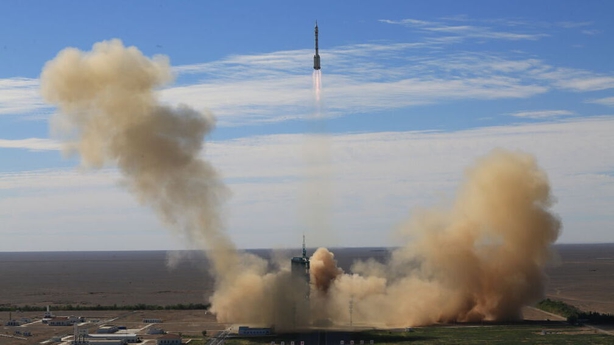The first astronauts sent to China’s new space station blasted off on the country’s longest manned mission to date, a historic step in establishing Beijing as a major space power.
The trio launched a Long March-2F missile for Tiangong Station, where they will spend three months, in a long-awaited live broadcast on state television.
Liftoff occurred at 9.22 a.m. (2.22 a.m. Irish time) from the Jiuquan Launch Center in the Gobi Desert in northwest China, with the rocket soaring amid clouds of smoke over a blue sky.
About 10 minutes later it reached orbit and the spacecraft detached from the rocket, to loud applause in the control room among the rows of engineers in blue suits.
The State Broadcasting Corporation (CCTV) showed a live broadcast from inside the spacecraft, with the three astronauts lifting their helmet visors and one smiling and waving at the camera.
Another stylus floated off his knees in zero gravity while he was browsing through the itinerary.
Cameras outside the vehicle are broadcasting live images of the Earth below.
«According to reports from the Beijing Aerospace Control Center, the Long March-2F rocket sent the Shenzhou-12 manned spacecraft to the predetermined orbit,» said Zhang Zhifen, director of the Jiuquan Satellite Launch Center.
«The solar panels have been successfully revealed and now we announce that the launch of Shenzhou-12 is a complete success.»
At a pre-launch ceremony, the three astronauts, already in their spacesuits, were greeted by a crowd of supporters and space workers, who sang the patriotic song «Without the Chinese Communist Party, there will be no New China.»
The mission leader is Ni Haisheng, a decorated Air Force pilot in the People’s Liberation Army who has already participated in two space missions.
The other two members are also members of the military.
Their Shenzhou-12 spacecraft will dock with the main body of the Tianhe Space Station, which was put into orbit on April 29, possibly six hours after liftoff.
The module contains separate living spaces each, a ‘treadmill’ and exercise bike, and a call center for emails and video calls with ground control.
It is the first manned mission to China in nearly five years.
The astronauts will conduct two spacewalks during the mission, both of which will last about six or seven hours, said Huang Weifen of China’s manned space program.
She also said the trio will wear newly developed space suits for their spacewalks.
The launch is a matter of great prestige in China, as Beijing prepares to celebrate the centenary of the ruling Communist Party on July 1.
To prepare for the mission, the crew underwent more than 6,000 hours of training, including hundreds of underwater somersaults in full space equipment.
The Chinese space agency is planning a total of 11 launches by the end of next year, including three more manned missions that will provide two laboratory units to expand the 70-tonne station, supplies and crew members.
China’s space ambitions have been fueled in part by the US ban on astronauts on the International Space Station, a collaboration between the United States, Russia, Canada, Europe and Japan.
It is set to retire after 2024, although NASA has said it will likely still operate after 2028.
Tiangong will be much smaller than the International Space Station, and is expected to be at least 10 years old.
China has said it will be open to international cooperation on its space station, although it has not yet provided specific details.
«Foreign astronauts will certainly enter the Chinese space station one day,» said Zhou Jianping, chief designer of the space program.
«There are a number of countries that have expressed a desire to do this and we will be open to that in the future,» he said.
Beijing said in March it also plans to build a separate lunar space station with Russia, and this week the two countries released a «road map» of potential cooperation opportunities.

«Lector profesional. Jugador galardonado. Aficionado a los zombis. Adicto a las redes sociales. Experto en tocino. Erudito en Internet»
